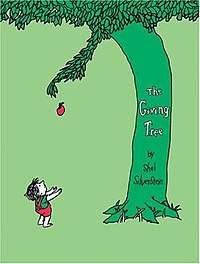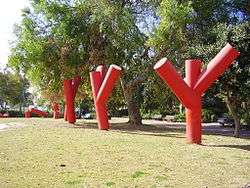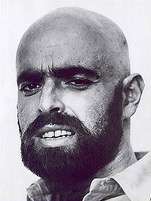The Giving Tree
The Giving Tree is an American children's picture book written and illustrated by Shel Silverstein. First published in 1964 by Harper & Row, it has become one of Silverstein's best-known titles, and has been translated into numerous languages.
 The cover, depicting The Giving Tree offering an apple to the Boy | |
| Author | Shel Silverstein |
|---|---|
| Genre | Children's picture book |
| Publisher | Harper & Row |
Publication date | October 7, 1964 (55 years old) |
| ISBN | 978-0-06-025665-4 |
| Followed by | Who Wants a Cheap Rhinoceros? |

This book has been described as "one of the most divisive books in children's literature"; the controversy stems from whether the relationship between the main characters (a boy and the titular tree) should be interpreted as positive (i.e., the tree gives the boy selfless love) or negative (i.e., the boy and the tree have an abusive relationship).
Background
Silverstein had difficulty finding a publisher for The Giving Tree.[1][2] An editor at Simon & Schuster rejected the book's manuscript because he felt that it was "too sad" for children and "too simple" for adults.[1][2] Tomi Ungerer encouraged Silverstein to approach Ursula Nordstrom, who was a publisher with Harper & Row.[1]
An editor with Harper & Row stated that Silverstein had made the original illustrations "scratchy" like his cartoons for Playboy, but that he later reworked the art in a "more pared-down and much sweeter style."[3] The final black-and-white drawings have been described as "unadorned… visual minimalism."[4] Harper & Row published a small first edition of the book, consisting of only 5,000–7,500 copies, in 1964.[5]
Plot
The book follows the lives of an apple tree and a boy, who develop a relationship with one another. The tree is very "giving" and the boy evolves into a "taking" teenager, man, then elderly man. Despite the fact that the boy ages in the story, the tree addresses the boy as "Boy" his entire life.
In his childhood, the boy enjoys playing with the tree, climbing her trunk, swinging from her branches, carving "Me + T (Tree)" into the bark, and eating her apples. However, as the boy grows older, he spends less time with the tree and tends to visit her only when he wants material items at various stages of his life, or not coming to the tree alone (such as bringing a lady friend to the tree and carving "Me +Y.L." (her initials, often assumed to be an acronym for "young love") into the tree. In an effort to make the boy happy at each of these stages, the tree gives him parts of herself, which he can transform into material items, such as money (from her apples), a house (from her branches), and a boat (from her trunk). With every stage of giving, "the Tree was happy".
In the final pages, both the tree and the boy feel the sting of their respective "giving" and "taking" nature. When only a stump remains for the tree (including the carving "Me + T"), she is not happy, at least at that moment. The boy does return as a tired elderly man to meet the tree once more. She tells him she is sad because she cannot provide him shade, apples, or any materials like in the past. He ignores this (because his teeth are too weak for apples, and he is too old to swing on branches and too tired to climb her trunk) and states that all he wants is "a quiet place to sit and rest," which the tree, who is weak being just a stump, could provide. With this final stage of giving, "the Tree was happy".
Reception
Interest in the book increased by word of mouth; for example, in churches "it was hailed as a parable on the joys of giving."[1] As of 2001, over 5 million copies of the book had been sold, placing it 14th on a list of hardcover "All-Time Bestselling Children's Books" from Publishers Weekly.[6] By 2011, 8.5 million copies of the book had been sold.[2]
In a 1999–2000 National Education Association online survey of children, among the "Kids' Top 100 Books," the book was 24th.[7] Based on a 2007 online "Teachers' Top 100 Books for Children" poll by the National Education Association, the book came in third.[8] It was 85th of the "Top 100 Picture Books" of all time in a 2012 poll by School Library Journal.[9] Scholastic Parent & Child magazine placed it #9 on its list of "100 Greatest Books for Kids" in 2012.[10] As of 2013, it ranked third on a Goodreads list of "Best Children's Books."[11]
Interpretations
There are numerous interpretations of the book, including:[12][13]
Religious interpretation
Ursula Nordstrom attributed the book's success partially to "Protestant ministers and Sunday-school teachers", who believed that the tree represents "the Christian ideal of unconditional love."[14]
Environmental interpretation
Some people believe that the tree represents Mother Nature and the boy represents humanity. The book has been used to teach children environmental ethics.[15] An educational resource for children describes the book as an "allegory about the responsibilities a human being has for living organisms in the environment,"[16] Lisa Rowe Fraustino states that “some curricula use the book as a what-not-to-do role model."[13]
Friendship interpretation
One writer believes that the relationship between the boy and the tree is one of friendship. As such, the book teaches children "as your life becomes polluted with the trappings of the modern world — as you 'grow up' — your relationships tend to suffer if you let them fall to the wayside."[17] Another writer's criticism of this interpretation is that the tree appears to be an adult when the boy is young, and cross-generational friendships are rare.[17] Additionally, this relationship can be seen from a humanities perspective, emphasizing the need for helping each other. [18]
Parent–child interpretations
A common interpretation of the book is that the tree and the boy have a parent–child relationship, as in a 1995 collection of essays about the book edited by Richard John Neuhaus in the journal First Things.[19] Among the essayists, some were positive about the relationship; for example, Amy A. Kass wrote about the story that "it is wise and it is true about giving and about motherhood," and her husband Leon R. Kass encourages people to read the book because the tree "is an emblem of the sacred memory of our own mother's love."[19] Other essayists put forth negative views. Mary Ann Glendon wrote that the book is "a nursery tale for the 'me' generation, a primer of narcissism, a catechism of exploitation," and Jean Bethke Elshtain felt that the story ends with the tree and the boy "both wrecks."[19]
A 1998 study using phenomenographic methods found that Swedish children and mothers tended to interpret the book as dealing with friendship, while Japanese mothers tended to interpret the book as dealing with parent–child relationships.[12]
Interpretation as satire
Some authors believe that the book is not actually intended for children, but instead should be treated as a satire aimed at adults along the lines of A Modest Proposal by Jonathan Swift.[20][21]
Criticism and controversy
Elizabeth Bird, writing for the School Library Journal, described The Giving Tree as "one of the most divisive books in children's literature".[22] Criticism revolves about the depiction of the relationship between the boy and the tree.[23]
Totally self-effacing, the 'mother' treats her 'son' as if he were a perpetual infant, while he behaves toward her as if he were frozen in time as an importunate baby. This overrated picture book thus presents as a paradigm for young children a callously exploitative human relationship — both across genders and across generations. It perpetuates the myth of the selfless, all-giving mother who exists only to be used and the image of a male child who can offer no reciprocity, express no gratitude, feel no empathy — an insatiable creature who encounters no limits for his demands.
Winter Prosapio said that the boy never thanks the tree for its gifts.[24] In an interview with Horn Book Magazine, Phyllis J. Fogelman, an editor with Harper & Row, said the book is "about a sadomasochistic relationship" and "elevates masochism to the level of a good",[3] which mirrors Mary Daly's analysis in Gyn/Ecology: the Metaethics of Radical Feminism.[25]
One college instructor discovered that the book caused both male and female remedial reading students to be angry because they felt that the boy exploited the tree.[26] For teaching purposes, he paired the book with a short story by Andre Dubus entitled "The Fat Girl" because its plot can be described as The Giving Tree "in reverse."[26]
Some readers may interpret the book against the wider background of Silverstein's interactions with women, e.g., that he frequented the Playboy Mansion and Playboy Clubs, and allegedly, according to his biography A Boy Named Shel,[27] slept with hundreds, perhaps thousands of women.[28]
Author's photograph

The photograph of Silverstein on the back cover of the book has attracted attention.[22][29] One writer described the photograph as showing the author's "jagged menacing teeth" and "evil, glaring eyes."[30] Another writer compared the photograph to the one on the back of Where the Sidewalk Ends in which Silverstein resembles "the Satanist Anton LaVey."[31]
Cultural influences and adaptations
Other versions
A short animated film of the book, produced in 1973, featured Silverstein's narration.[32][33]
Silverstein also wrote a song of the same name, which was performed by Bobby Bare and his family on his album Singin' in the Kitchen (1974).[34]
Silverstein created an adult version of the story in a cartoon entitled "I Accept the Challenge."[31] In the cartoon, a nude woman cuts off a nude man's arms and legs with scissors, then sits on his torso in a pose similar to the final drawing in The Giving Tree in which the old man sits on the stump.[31]
Jackson and Dell (1979) wrote an "alternative version" of the story for teaching purposes that was entitled "The Other Giving Tree."[20] It featured two trees next to each other and a boy growing up. One tree acted like the one in The Giving Tree, ending up as a stump, while the other tree stopped at giving the boy apples, and does not give the boy its branches or trunk. At the end of the story, the stump was sad that the old man chose to sit under the shade of the other tree.[20]
Playwright Topher Payne (2019) wrote an alternate ending for the book, "The Tree Who Set Healthy Boundaries", as part of the "Topher Fixed It" series for young people. In this version the tree teaches the boy to become a better person. They are both better off for the tree's efforts, and so is the world around them. [35]
Cultural influences
The Giving Tree Band took its name from the book.[36] Plain White T's EP Should've Gone to Bed has a song “The Giving Tree,” written by Tim Lopez. The 2010 short film I'm Here, written and directed by Spike Jonze, is based on The Giving Tree; the main character Sheldon is named after Shel Silverstein.[37]
References
- Cole, William (September 9, 1973). "About Alice, a Rabbit, a Tree...". The New York Times. p. 394.
- Paul, Pamela (September 16, 2011). "The Children's Authors Who Broke the Rules". The New York Times. Retrieved May 18, 2013.
- Marcus, Leonard S. (March–April 1999). "An Interview with Phyllis J. Fogelman" (PDF). Horn Book Magazine. 75 (2): 148–164. Archived from the original (PDF) on 2013-01-08. Retrieved May 18, 2013.
- Spitz, Ellen Handler (1999). Inside Picture Books. New Haven, CT: Yale University Press. pp. 142–144. ISBN 0300076029.
- Natov, Roni & Geraldine DeLuca (1979). "Discovering Contemporary Classics: an Interview with Ursula Nordstrom". The Lion and the Unicorn. 3 (1): 119–135. doi:10.1353/uni.0.0355. Retrieved May 18, 2013.
- Roback, Diane, Jason Britton, and Debbie Hochman Turvey (December 17, 2001). "All-Time Bestselling Children's Books". Publishers Weekly. 248 (51). Retrieved May 18, 2013.CS1 maint: multiple names: authors list (link)
- National Education Association. "Kids' Top 100 Books". Archived from the original on February 1, 2013. Retrieved May 18, 2013.
- National Education Association (2007). "Teachers' Top 100 Books for Children". Retrieved May 18, 2013.
- Bird, Elizabeth (May 18, 2013). "Top 100 Picture Books Poll Results". School Library Journal "A Fuse #8 Production" blog. Retrieved August 19, 2012.
- "Parent & Child 100 Greatest Books for Kids" (PDF). Scholastic Corporation. 2012. Retrieved May 18, 2013.
- "Best Children's Books". Goodreads. 2008. Retrieved May 18, 2013.
- Pramling Samuelsson, Ingrid; Mauritzson, Ulla; Asplund Carlsson, Maj; Ueda, Miyoko (1998). "A Mother and a Friend: Differences in Japanese and Swedish Mothers' Understanding of a Tale". Childhood. 5 (4): 493–506. doi:10.1177/0907568298005004008. ISSN 0907-5682.
- Fraustino, Lisa Rowe (2008). "At the Core of The Giving Tree's Signifying Apples". In Magid, Annette M. (ed.). You Are What You Eat: Literary Probes into the Palate. Newcastle, UK: Cambridge Scholars. pp. 284–306. ISBN 9781847184924.
- Marcus, Leonard S. (May 15, 2005). "'Runny Babbit': Hoppity Hip". The New York Times. Retrieved May 18, 2013.
- Goodnough, Abby (April 16, 2010). "The Examined Life, Age 8". The New York Times. Retrieved May 18, 2013.
- Fredericks, Anthony D. (1997). "26. The Giving Tree". The Librarian's Complete Guide to Involving Parents Through Children's Literature Grades K-6. Englewood, CO: Libraries Unlimited. p. 28. ISBN 1563085380.
- Belkin, Lisa (September 8, 2010). "Children's Books You (Might) Hate". "Motherlode: Adventures in Parenting" blog. New York Times. Retrieved May 18, 2013.
- Cousin E. The Giving Tree: A Modern-Day Parable of Mutual Responsibility. Michigan Law Review. 2015;113(6):767-776. http://search.ebscohost.com.lp.hscl.ufl.edu/login.aspx?direct=true&AuthType=ip,uid&db=buh&AN=102221722&site=eds-live. Accessed February 23, 2020
- May, William F., Amy A. Kass, Marc Gellman, Midge Decter, Gilbert Meilaender, Mary Ann Glendon, William Werpehowski, Timothy Fuller, Leon R. Kass, Timothy P. Jackson, Jean Bethke Elshtain, Richard John Neuhaus (January 1995). "The Giving Tree: A Symposium". First Things. The Institute on Religion and Public Life. Archived from the original on May 12, 2013. Retrieved May 18, 2013.CS1 maint: multiple names: authors list (link)
- Jackson, Jacqueline & Carol Dell (1979). "The Other Giving Tree". Language Arts. 56 (4): 427–429. JSTOR 41404822.
- Strandburg, Walter L. & Norma J. Livo (1986). "The Giving Tree or There is a Sucker Born Every Minute". Children's Literature in Education. 17 (1): 17–24. doi:10.1007/BF01126946.
- Bird, Elizabeth (May 18, 2012). "Top 100 Picture Books #85: The Giving Tree by Shel Silverstein". School Library Journal "A Fuse #8 Production" blog. Retrieved May 18, 2013.
- Spitz, Ellen Handler (May–June 1999). "Classic children's book". American Heritage. 50 (3): 46. Retrieved May 18, 2013.
- Prosapio, Winter (May 12, 2006). "A Lesson from 'The Giving Tree'". The Christian Science Monitor. Retrieved May 18, 2013.
- Daly, Mary (1990). Gyn/Ecology: the Metaethics of Radical Feminism. Boston: Beacon Press. p. 90. ISBN 0807014133.
Here is a model for masochism for female readers of all ages, and of sadism for boys of all ages...The saccharine sweet story of a little boy who 'loves' a tree—a young Apollo who crowns himself with her leaves—has 'healthier' appeal than overt S and M biblical tales of a dead godman crowned with thorns.
- Juchartz, Larry R (December 2003 – January 2004). "Team Teaching with Dr. Seuss and Shel Silverstein in the College Basic Reading Classroom". Journal of Adolescent & Adult Literacy. 47 (4): 336–341.
- Lisa Rogak, 2007, A Boy Named Shel: The Life and Times of Shel Silverstein, Thomas Dunne Books. ISBN 9780312539313
- See, e.g., Ruth Margalit, ""The Giving Tree" At Fifty: Sadder Than I Remember, The New Yorker, 5 November 2014, https://www.newyorker.com/books/page-turner/giving-tree-50-sadder-remembered
- Kogan, Rick (July 12, 2009). "'SHELebration: A Tribute to Shel Silverstein' to Honor Writer Born in Chicago". Chicago Tribune. Retrieved May 18, 2013.
- Ruhalter, Eric (January 11, 2010). "Children's books that creep me out: What was up with 'Natural Bear?'". New Jersey On-Line. Retrieved May 18, 2013.
- Thomas, Jr., Joseph (2016-09-10). "Reappraising Uncle Shelby" (PDF). The Horn Book Magazine. Archived from the original (PDF) on 2016-09-10. Retrieved 2018-11-02.CS1 maint: multiple names: authors list (link)
- Bosustow, Nick, and Shel Silverstein (Producers); Hayward, Charlie O. (Director and Animator); Silverstein, Shel (Original Story, Music, and Narration) (1973). The Giving Tree (VHS). Chicago, IL: SVE & Churchill Media. OCLC 48713769.
- "The Giving Tree: Based on the Book and Drawings by Shel Silverstein". YouTube. Churchill Films. 1973. Retrieved May 18, 2013.
- Bobby Bare and the Family (Musicians); Silverstein, Shel (Principal Composer) (1973). Singin' in the Kitchen (LP). New York: RCA Victor. OCLC 6346534.
- https://www.topherpayne.com/giving-tree
- Markstrom, Serena (June 18, 2010). "Giving Tree Band Takes Story to Heart". The Register-Guard. Retrieved May 18, 2013.
- Coates, Kristen (February 8, 2010). "[Sundance Review] Spike Jonze Creates Unique Love Story With 'I'm Here'". The Film Stage. Retrieved May 18, 2013.
'I was trying to take the influence of The Giving Tree, but write about relationships,' says Jonze. 'I love Shel Silverstein. I just love him.'
Further reading
- Moriya, Keiko (1989). "A Developmental and Crosscultural Study on the Interpersonal Cognition of Swedish and Japanese Children". Scandinavian Journal of Educational Research. 33 (3): 215–227. doi:10.1080/0031383890330304.
- Asplund Carlsson, Maj; Pramling, Ingrid; Wen, Qiufeng; Izumi, Chise (1996). "Understanding a Tale in Sweden, Japan and China". Early Child Development and Care. 120 (1): 17–28. doi:10.1080/0300443961200102.
- Miller, Ellen (2012). "15: The Giving Tree and Environmental Philosophy: Listening to Deep Ecology, Feminism and Trees". In Costello, Peter R (ed.). Philosophy in Children's Literature. Lanham, MD: Lexington Books. pp. 251–266. ISBN 9780739168233.
- Radeva, Milena (2012). "16: The Giving Tree, Women, and the Great Society". In Costello, Peter R (ed.). Philosophy in Children's Literature. Lanham, MD: Lexington Books. pp. 267–283. ISBN 9780739168233.
- Hinson-Hasty, Elizabeth (2012). "Revisiting Feminist Discussions of Sin and Genuine Humility". Journal of Feminist Studies in Religion. 28 (1): 108–114. doi:10.2979/jfemistudreli.28.1.108.
External links
- Lindsey, Charley (June 11, 2004). "Silverstein's 'The Giving Tree' Celebrates 40 Years in Print". Knight Ridder Newspapers.
- Westley, Christopher (October 21, 2004). "That Insufferable 'Giving Tree'". Mises Daily. Ludwig von Mises Institute.